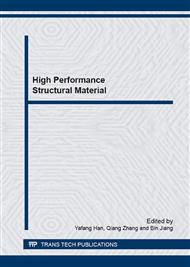p.655
p.662
p.671
p.676
p.682
p.688
p.694
p.699
p.705
Preparation and Characterization of Amorphous Al-Based Metal Foams
Abstract:
Amorphous Al-Cu-Ti metal foams with the porosity of 65% were prepared by spark plasma sintering with both the diameter and height of 10 mm. The SPS process was carried out under the pressure, the dwell time and the temperatures of 300 MPa, 5min and 623-673K, respectively. The microstructure and mechanical behavior of the amorphous Al-Cu-Ti metal foams were investigated. The results showed that sintering at high temperatures improved the crystallinity and adhesion between particles. The intermetallic compounds, i.e. Al-Ti, Al-Cu and Al-Cu-Ti were identified from the XRD patterns. It was found that weak adhesion and irregular shape of NaCl might reduce the mechanical properties. The highest strength of amorphous Al-based metal foam sintered at 653K, 300MPa was 7.97MPa.
Info:
Periodical:
Pages:
682-687
Citation:
Online since:
April 2015
Authors:
Price:
Сopyright:
© 2015 Trans Tech Publications Ltd. All Rights Reserved
Share:
Citation:


